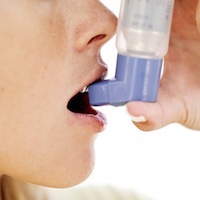The key to easy asthma diagnosis is in the blood
Using just a single drop of blood, a team of UW–Madison researchers has developed a faster, cheaper and more accurate tool for diagnosing even mild cases of asthma.
This handheld technology — which takes advantage of a previously unknown correlation between asthmatic patients and the most abundant type of white blood cells in the body — means doctors could diagnose asthma even if their patients are not experiencing symptoms during their visit to the clinic.

A new tool uses a single drop of blood to diagnose even mild cases of asthma.
The team described its findings in the journal Proceedings of the National Academy of Sciences (PNAS) published online on April 7. The researchers used neutrophil cell function in a clinical study to show accurate asthma diagnosis.
“What we’ve done in this paper is presented data that neutrophil cell function in some cases can predict — and in this case actually predicted and measured — whether someone is asthmatic or not,” says David Beebe, a UW–Madison professor of biomedical engineering and co-author on the paper. “This is one of the first studies to show that this process could actually work in a cheap, easy and practical way.”
Asthma remains a very difficult disorder to accurately diagnose. Currently, asthma diagnosis consists of a series of clinical tests, often heavily informed by lung functionality tests. “They’ll measure how much air you can take in, and they’ll measure different chemical components of the respired air,” Beebe says.
Many of the current tests for diagnosing asthma rely at least partially on the patient experiencing symptoms during or close to their physician visit. Additionally, all of the diagnostic tests require the patient’s compliance, which can make diagnosis difficult for the elderly or in children. “Right now, asthma diagnosis is based on indirect measures,” Beebe says, “which is not optimal. So the premise in this paper was that cell function could be used to diagnose asthma and that we could measure cell function in way that was simple and cheap enough to be used clinically.”

David Beebe
To directly diagnose asthma, Beebe and his team focused on the cell function of neutrophils. Neutrophils are the most abundant white blood cell in the body and generally are the first cells to migrate toward inflammation. “Neutrophils are sort of like a dog tracking something. They sense a chemical gradient, like an odor, in the body,” Beebe says.
In other words, the human body emits chemical signals in response to inflammation or wounds and the neutrophils detect those chemical signals and migrate to the site of the wound to aid in the healing process. Researchers can track the velocity at which the neutrophil cells migrate — the chemotaxis velocity — to differentiate nonasthmatic samples from the significantly reduced chemotaxis velocity of asthmatic patients.
Traditionally, a clinical study of neutrophils required so much blood work, specialized equipment and processing that it was impractical to use in diagnostics. However, UW–Madison students developed the kit-on-a-lid-assay (KOALA) microfluidic technology, which allows them to detect neutrophils using just a single drop of blood.
The KOALA diagnostic procedure is very simple. Using simple lids and bases (each being a small, cheap piece of plastic), diagnosticians place a KOALA lid containing a chemical mixture onto the base containing the blood sample. That chemical mixture triggers neutrophil migration — and researchers can automatically track and analyze the neutrophil chemotaxis velocity using custom software.
The technology means doctors could diagnose asthma even if their patients are not experiencing symptoms during their visit to the clinic.
Beebe emphasizes that by using the KOALA lids containing premixed chemicals, the diagnostic procedure is scalable, cheap, quick and repeatable. “The KOALA platform represents the next-generation biomedical research kit,” he says. “Instead of getting a box of media and staining solution and having to do a lot of manual manipulation, you would get the base for the fluid sample, the prepackaged KOALA lids, and to do any testing, just place a lid (or series of lids) on the base.”
Other UW–Madison collaborators on the project include recent graduate Eric Karl-Heniz Sackmann; Erwin Berthier, a research scientist in biomedical engineering; Elizabeth Schwantes and Paul Fichtinger, allergy and immunology research specialists; Michael Evans, a biostatistician in the department of biostatistics and medical informatics; Anna Huttenlocher, a pediatrics professor; Sameer Mathur, an allergy and immunology associate professor; and Laura Dziadzio, formerly of the UW.
—John Steeno
Enjoy this story?
Read more news from the College of EngineeringSubscribe to Wisconsin Ideas
Want more stories of the Wisconsin Idea in action? Sign-up for our monthly e-newsletter highlighting how Badgers are taking their education and research beyond the boundaries of the classroom to improve lives.
